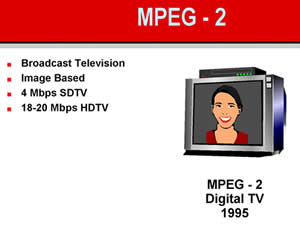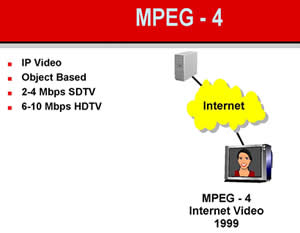Difference between MPEG2 and MPEG4
Key difference: MPEG stands for the Moving Picture Experts Group. MPEG2 was released in 1995 and is effectively the successor to MPEG1. It is quite similar MPEG1, and aimed to improve on the previous format. MPEG2 includes generic coding of moving pictures and associated audio information. MPEG4 was released in 1999 and was developed as an encoding method for devices with limited resources, mainly portable devices such as media players and mobile phones. This format is also often for online video and audio files, mainly streaming media, as well as for CD distribution, telephone, videophone and broadcast television applications.
 MPEG stands for the Moving Picture Experts Group. It is a working group of experts that was formed in 1988 by ISO and IEC. It was a joint initiative between Hiroshi Yasuda of the Nippon Telegraph and Telephone and Leonardo Chiariglione. Chiariglione has served as the group’s Chair since the group’s inception.
MPEG stands for the Moving Picture Experts Group. It is a working group of experts that was formed in 1988 by ISO and IEC. It was a joint initiative between Hiroshi Yasuda of the Nippon Telegraph and Telephone and Leonardo Chiariglione. Chiariglione has served as the group’s Chair since the group’s inception.
The aim of MPEG was to set standards for audio and video compression and transmission. By 2005, the group has grown to include approximately 350 members per meeting from various industries, universities, and research institutions.
The standards as set by MPEG consist of different Parts. Each part covers a certain aspect of the whole specification. MPEG has standardized the following compression formats and ancillary standards:
- MPEG-1 (1993): Coding of moving pictures and associated audio for digital storage media at up to about 1.5 Mbit/s (ISO/IEC 11172). Designed to compress VHS-quality raw digital video and CD audio without excessive quality loss, making video CDs, digital cable/satellite TV and digital audio broadcasting (DAB) possible. It includes the popular MPEG1 Audio Layer III (MP3) audio compression format.
- MPEG-2 (1995): Generic coding of moving pictures and associated audio information (ISO/IEC 13818). Describes a combination of lossy video compression and lossy audio data compression methods, which permit storage and transmission of movies using currently available storage media and transmission bandwidth.
- MPEG-3: Dealt with standardizing scalable and multi-resolution compression and was intended for HDTV compression but was found to be redundant and was merged with MPEG2.
- MPEG-4 (1999): Coding of audio-visual objects. Includes compression of AV data for web (streaming media) and CD distribution, voice (telephone, videophone) and broadcast television applications. It includes the MPEG-4 Part 14 (MP4).
- MPEG-7 (2002): Multimedia content description interface. Not a standard which deals with the actual encoding of moving pictures and audio, like MPEG1, MPEG2 and MPEG4. It uses XML to store metadata, and can be attached to timecode in order to tag particular events, or synchronize lyrics to a song.
- MPEG-21 (2001): Multimedia framework. It is aimed at defining an open framework for multimedia applications. Based on definition of a Digital Item and users interacting with Digital Items.
MPEG2 was released in 1995 and is effectively the successor to MPEG1. It is quite similar MPEG1, and aimed to improve on the previous format. MPEG2 includes generic coding of moving pictures and associated audio information. It improves the compression factor and enhances the capabilities of MPEG1, so that MPEG2 is mainly used for DVD videos, as well as broadcasting digital television including terrestrial, cable and satellite.
MPEG2 is also a lossy compression, however, MPEG2 allows for better resolution. It also used higher bit-rates. A lossy compression means that while saving a file, there is a slight loss of quality due to compression. With each re-save there a slight loss of quality due to compression. Hence, it is not the greatest format in case one needs to keep making numerous edits and re-saves to the image. Still, if one only makes a few edits and the file is saved in a high quality format, the slight loss of quality due to compression is mainly negligible. An advantage to using this format is that due to compression, the file will take up less space for data storage.
Furthermore, MPEG2 addressed some weaknesses of the MPEG1, which included:
- Audio compression limited to two channels
- No standardized support for interlaced video with poor compression when used for interlaced video
- Limited standardized profile which was incompatible for video with higher resolutions. Support for 4k video but no practical way to encode video for higher resolutions
- Limited identification of supporting hardware
- Only one color space support – 4:2:0
Additionally, MPEG2 also incorporated support for Variable quantization and VBR. MPEG2 also has a more complex encoding algorithm, due to which it is in incompatible with MPEG1. Hence, MPEG1 players are not able to decode and play MPEG2 files.
 MPEG4 was released in 1999 and was developed as an encoding method for devices with limited resources, mainly portable devices such as media players and mobile phones. This format is also often for online video and audio files, mainly streaming media, as well as for CD distribution, telephone, videophone and broadcast television applications.
MPEG4 was released in 1999 and was developed as an encoding method for devices with limited resources, mainly portable devices such as media players and mobile phones. This format is also often for online video and audio files, mainly streaming media, as well as for CD distribution, telephone, videophone and broadcast television applications.
MPEG4 is based on MPEG-1 and MPEG-2 standard and like them is a graphics and video lossy compression algorithm standard. However, MPEG-4 files are smaller in size and hence are preferred for streaming online or storing on portable players with limited disk space. This is mainly because MPEG-4 is based on wavelet technology that can compress color images at rates of 20:1 up to 300:1 and grayscale images at 20:1 to 50:1. Furthermore, the MPEG4 compression mechanism is a bit more complicated as compared to that of MPEG2. This is because MPEG4 needs better algorithms to scan and determine which pixels can be discarded, to reduce the data size even further.
Wikipedia lists the following as features of MPEG4:
- MPEG-4 enables different software and hardware developers to create multimedia objects possessing better abilities of adaptability and flexibility to improve the quality of such services and technologies as digital television, animation graphics, the World Wide Web and their extensions.
- Data network providers can use MPEG-4 for data transparency. With the help of standard procedures, MPEG-4 data can be interpreted and transformed into other signal types compatible with any available network.
- The MPEG-4 format provides end users with a wide range of interaction with various animated objects.
- Standardized Digital Rights Management signaling, otherwise known in the MPEG community as Intellectual Property Management and Protection (IPMP).
MPEG4 has gotten quite popular over the years. One of its most commonly used formats is the .mp4. MPEG-4 Part 12 was developed from the Apple’s MOV file and eventually resulted in MPEG-4 Part 14, which is the MP4 format. The MP4 is a container format. This means that it can be used to store audio and/or video data. MP4 video and audio can also be streamed over the internet.
Image Courtesy: althos.com









Add new comment